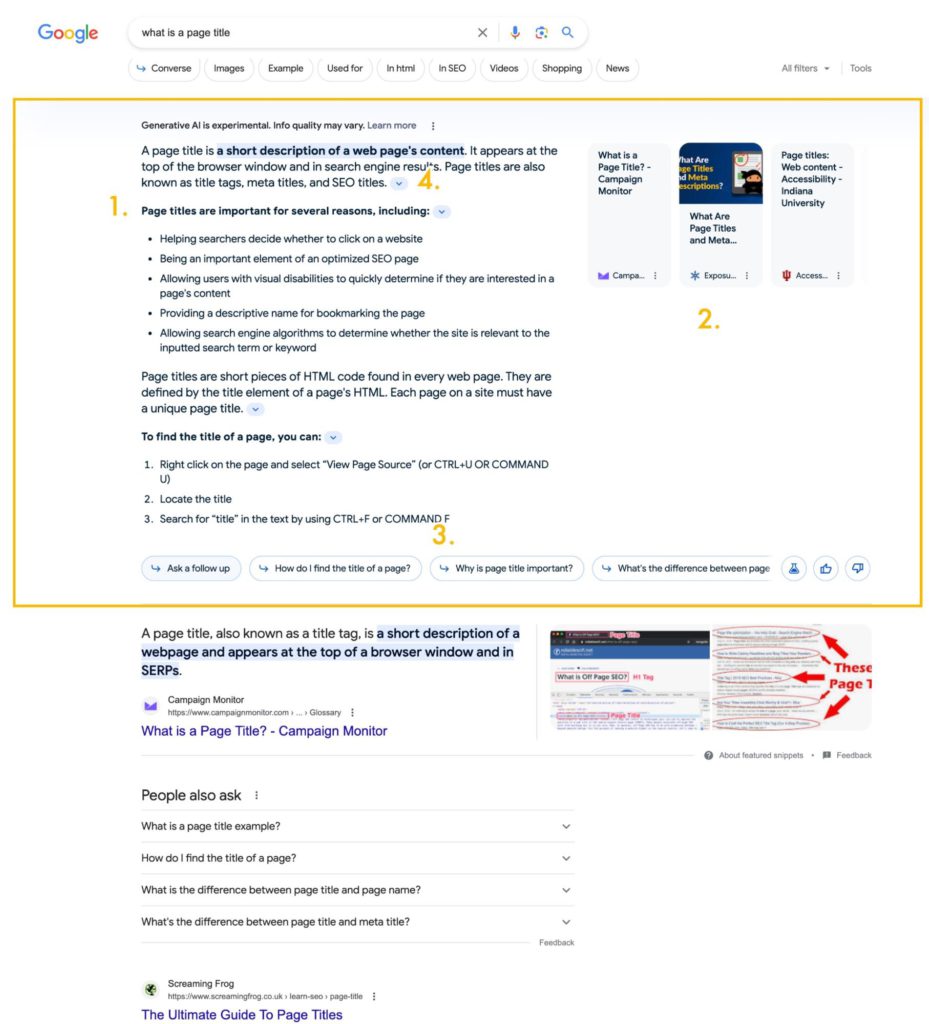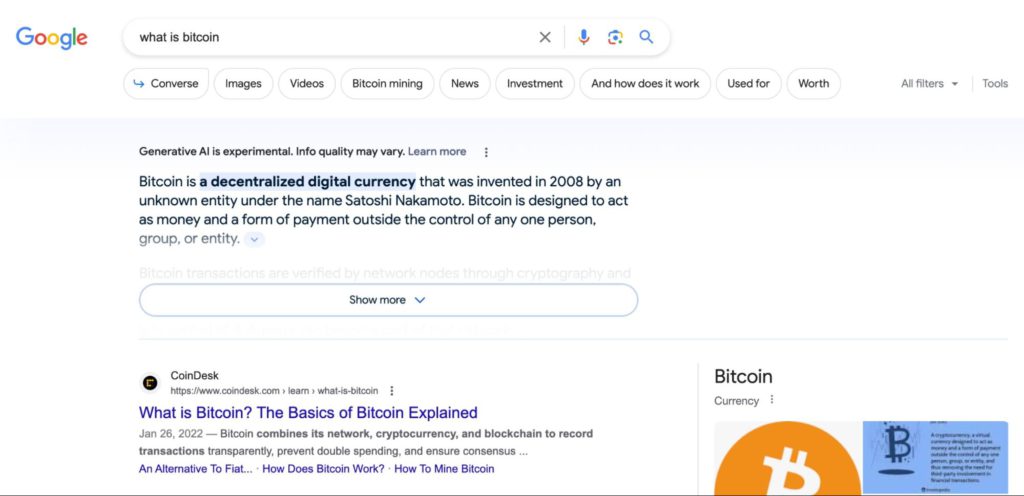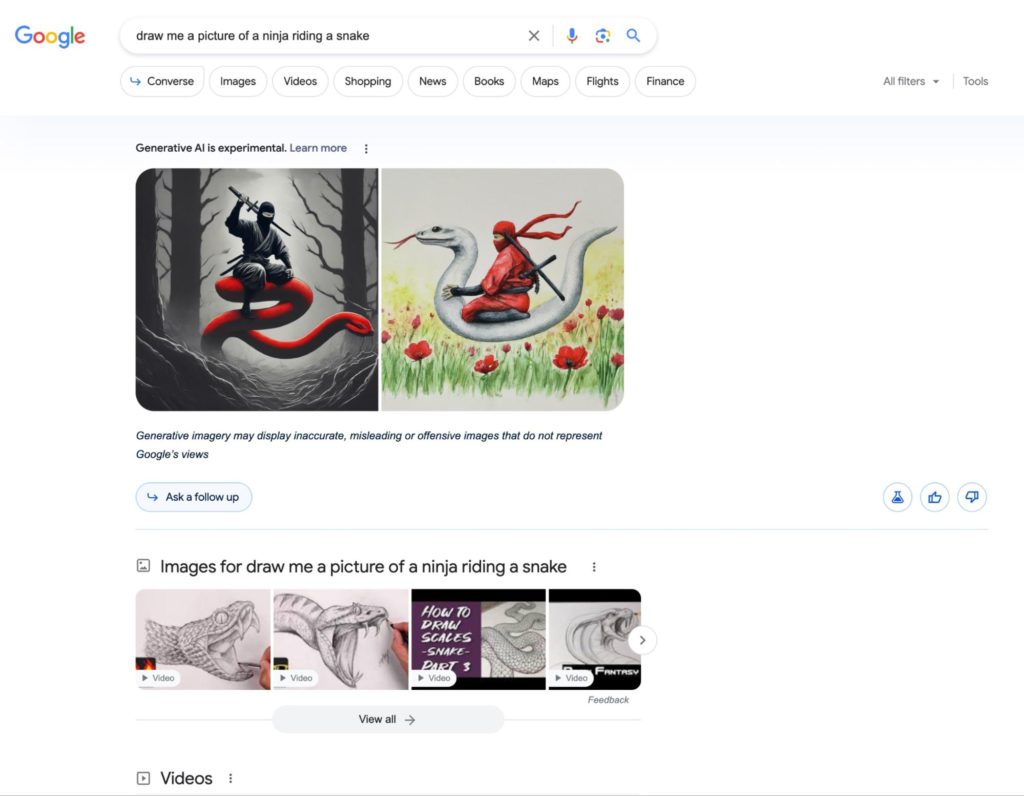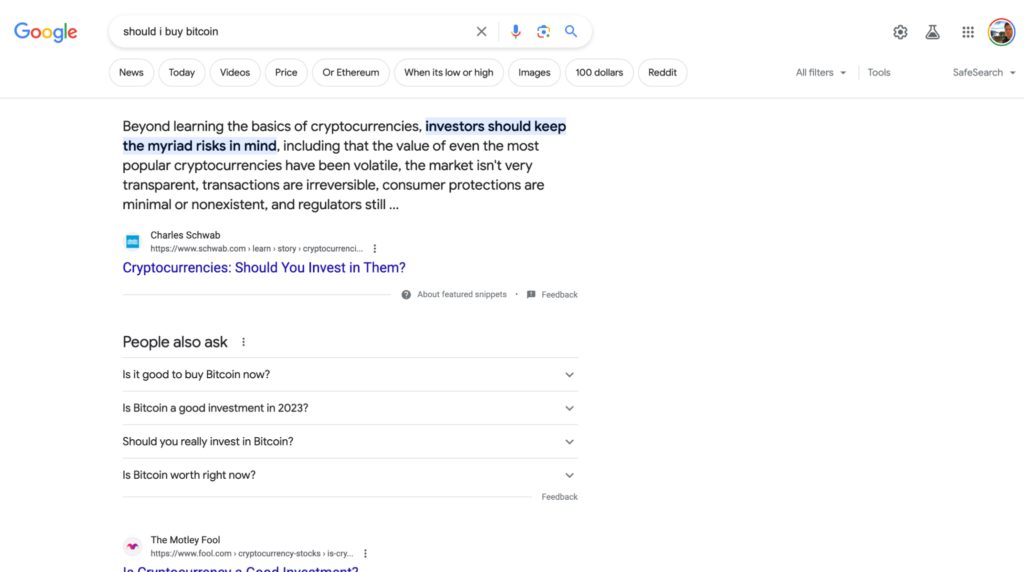
Advertisement
Google’s new AI-powered search engine SGE (Search Generative Experience) is poised to be released in the coming months. It is expected to reduce the amount of organic traffic websites enjoy from search, unless those websites also rank in the few linked slots in the SGE panel.
Briefly, we have found the keys to ranking your website in Google’s SGE are:
In this guide, we’ll share a comprehensive breakdown of these factors, with examples.
SGE, or Search Generative Experience, is a new type of search engine from Google that uses generative AI to answer the searcher’s query, in addition to providing links to websites that ‘support’ or ‘corroborate’ the answer the AI gives.
It has been in testing mode (available to users inside Google’s Search Labs testing pool) for much of 2023, ahead of an expected release in early 2024.
An SGE search results page looks like this, at the time of writing:

The SGE panel (boxed in yellow) sits above the ‘regular’ organic search results.
The key components of an SGE result are:
Currently, SGE answers appear in various forms for a variety of different types of searches. Sometimes the SGE panel can be seen with a link to Show more button. This seems to be the current ‘default’ way:

Other times, the searcher has the option of clicking Generate to produce an SGE panel. We suspect that Google uses this option when it isn’t sure whether an SGE answer would be useful or not:

For some queries, an SGE panel is visible by default. In this case, SGE has actually created an AI image to answer the searcher’s query:

In some cases, Google opts not to show an SGE answer or even give the searcher an option to create one:

It’s common to see Google take this approach for searches relating to financial recommendations. Initially, Google said that SGE wouldn’t be available for ‘Your Money or Your Life’ (YMYL) searches. In our testing though, we’ve found plenty of SGE responses given for health and medical-related search queries. For example:

It is perhaps worth noting that Google has developed a medical-specific version of PaLM 2, the large language model powering SGE. This medical-specialist LLM (known as Med-PaLM 2) has been trained to give accurate medical advice. It’s possible that Google is relying on this specialist version to provide answers to medical-related questions, which would explain why Google has the confidence to allow SGE answers to questions which, if incorrectly answered, could lead to Google being guilty of sharing bad medical advice.
There are actually 4 ways to get visibility for your business in SGE. Three of them can be seen in this search, featuring Exposure Ninja client CHAS:

The first and most obvious way to benefit from SGE is to get your website listed in the ‘carousel’ links (1.). We’re expecting these to receive the lion’s share of the organic traffic produced by SGE, as they are the only ones shown when the SGE answer loads.
The second way to benefit is to be listed as a link in one of the SGE dropdowns (2). We’ve found that in the majority of cases, the websites listed in the carousel are the sites listed in the individual drop-downs.
The third way to benefit from SGE is much more rare. In some cases, we have seen SGE suggest a follow-up question to a search that includes a brand, as it does in the example above (3). For this particular search, CAS is a generic accreditation, whereas CHAS is a brand. It seems that over the years we have done so much content marketing to link CHAS with CAS, that SGE has treated them as closely related.
The fourth and final way to benefit from SGE is to have it recommend your business or product when asked:

Now, before I carry on, I want to preface this by saying that (at the time of writing) SGE is still in an experimental stage and is likely to improve and change as it progresses out of testing. The results of my tests (which are very positive, as you’ll soon read) are based on existing ranking factors. Should the factors change, the team and I will continue to innovate and iterate our tests to ensure we’re ahead of the game and consistently ranking our clients in the SGE results.
Step 1: Start from a Strong Base
From our tests, we have found that ranking in SGE is much easier if you are already ranking in the ‘regular’ organic results. This implies that SGE uses some of the same ranking signals as what we marketers and SEOs have been used to providing for many years.
Things like:
… all seem to help here.
However, ranking in the ‘regular’ organic results is NOT sufficient to necessarily get coverage in the SGE results, as you can see for this search, where the Exposure Ninja website was ranking #1 in the organic results but had no visibility in the SGE results:

Following the changes described below, however, we were able to correct this:

But it’s important to note that SGE ranking – particularly picking up the all-important first 3 carousel slots that are visible – can’t be relied on, just from doing ‘regular’ SEO.
In another example, notice here how the website providing the featured snippet isn’t listed in the first 3 carousel spots:

This demonstrates the importance of optimising specifically for SGE results, even if you have the ‘SEO basics’ covered.
Step 2: Match the Topic and Question Extremely Closely (Or Exactly)
We’ve found that it’s much easier to rank in SGE – and particularly in the carousel – with a content page matching exactly the target search term.
This feels a bit old-skool, as many digital marketers have spent the last few years writing ‘The Ultimate Guide to X, Y, Z’, attempting to answer every imaginable question about their target topic in as much detail as possible. Well, they may now find that a page of content called “How much does X cost?” actually seems to be easier to rank in SGE, even if it is much shorter.
In fact, in some of our tests, we were able to outrank established, high-authority sources of information with very short but narrowly targeted pages.
In this example, the featured snippet website (Facebook) was beaten in the SGE panel by one of the World’s Worst Blogs™ :

The blog ranking in the third carousel spot is truly rubbish:

That’s it – a two-sentence blog post, but so specifically targeted that it did the job. There are likely other factors in play as well in this case (not least the low competition for this search), which we’ll return to shortly.
I suspect that the ‘exact match blog post’ strategy won’t last long. This feels like a return to the days of exact match domains, when ranking a new website for a competitive search term was as easy as making the search term the URL. Soon enough, Google realised that scallywag SEOs were gaming the system, and closed that particular loophole.
I would be amazed if Google didn’t also close this loophole before websites start pumping out millions of short blog posts answering every version of every question imaginable. But for now, at least, the key seems to be to focus your content specifically on the keywords you want to target.
Step 3: Providing Simple Information with High Readability
When you click on a website linked from SGE, you’ll often notice the URL contains a hash (this is called a Text Fragment and currently used within regular Featured Snippets):

If you can’t read it, the above hashed URL says:
https://timck.ninja/blog/where-is-tim-cameron-kitchen-based/#:~:text=Tim%20is%20based%20in%20Cobham%2C%20Surrey.%20He,Luna%20and%20Luca%2C%20and%20one%20wife%20Katie.
The most interesting bit is the bit that goes (with %20, the HTML code for ‘space’ removed): text=Tim is based in Cobham, Surrey. He, Luna and Luca, and one wife Katie.
This tells the browser which part of the page to highlight:

And this section of the page seems to inform the SGE answer. In this particular case, the first paragraph of the SGE answer is a direct rewrite of the highlighted passage:

One thing I noticed as I was studying SGE results was that the passages highlighted in the linked websites were always short. This is because, even in a longer SGE answer, the linked website was being used to support one particular point.
For example:

The website that supports the ‘snake resemblance’ theory (used at the start of the SGE answer) wins 2nd place in the carousel for its efforts. The text that SGE highlights to support the snake resemblance theory is highlighted on the page:

Having studied dozens of SGE search results like this, I realised that these linked paragraphs seemed to predominantly be written in short
sentences and straightforward language. SGE also seemed to favour sentences and paragraphs that made a single point, rather than more complex paragraphs that (for example) discussed a number of reasons cats may be afraid of cucumbers.
My working theory is that because SGE is designed to provide short, easy-to-read answers, it needs to reference short, easy-to-read sentences to decrease the chances of summarising inaccurately or taking the point out of context. Another example in our deep-dive into cats vs cucumbers gives an SGE search result supported by the highlighted webpage on Hill’s Pet Nutrition:

Examining the highlighted sentences shows that SGE has essentially rewritten the second sentence. SGE didn’t opt to pull any further sentences or information from this page, despite them being highly relevant.

Step 4: ‘Getting to the Point’ and Giving the User the Information They Need Very Quickly on the Page.
I recently hosted a webinar sharing a series of SGE ranking ‘before and afters’. These are searches where the target website was ranking organically but wasn’t featured in the SGE results.
In addition to the other steps mentioned here, the one thing I made sure of in every case was that the opening paragraph of the blog page neatly summarised the answer to the question or topic, as I had noticed a lot of SGE-ranking pages did.
We started doing this when featured snippets first appeared in the search results, so it felt like a blast from the past.
In this example, the Exposure Ninja website wasn’t ranking in the SGE result for the search “sponsored tag”, despite ranking at position 1 in the regular organic results. To attempt to correct this, I added the following paragraph at the top of the blog post. I wrote this to try and neatly summarise the answer to this question and give Google/SGE the ‘support’ it needed for its answer:

Within 12 hours of submitting this page via Search Console for reindexing, we picked up a supporting link in the first paragraph of the SGE answer and a coveted carousel spot:

In one test case, I noticed after adding a new summary paragraph at the start of the article that SGE was still hashing and referencing a paragraph further down the page. This page was ranking in the SGE carousel, but outside the top 3. It was annoying that SGE was referencing the old paragraph, as I really didn’t feel that it was as good a summary as the new one I had written. Our CEO, Charlie, suggested removing the old paragraph altogether in case it was ‘confusing’ SGE. That worked. Within a matter of hours the new paragraph was being referenced and our SGE carousel ranking went into the first 3 positions.
Step 5: Being a Trusted Source of Information on the Topic
One night I was messing around to see if I could change SGEs answers. I started with this search:

Not to be pedantic, but this answer is actually wrong. There are two other (unknown and fairly rubbish) books on drumming and, bizarrely, career planning.
So I followed the formula outlined above and wrote a new, dedicated blog post on my personal website to target this topic. Much like the “where is Tim Cameron-Kitchen based” blog, this one was in with a chance of a trophy at the The World’s Worst Blog Post™ awards:

Lo and behold, within just 5 hours of publishing this and submitting via Search Console, SGE had ‘corrected’ its answer:

I was wondering how The World’s Worst Blog Post™ on my super low authority personal website https://timck.ninja could possibly cause SGE to change its answer, particularly if the answer given in TWWBP™ actually contradicted high authority websites like Amazon and Goodreads.
I did a similar search on Bing the next day, and Bing gave me an answer along the lines of “According to Amazon it’s five. But according to Tim’s own website it’s seven”. Super interesting, I thought. Bing knows that timck.ninja is an authority on this topic, not because it has many links or because it even has a lot of content. But because it belongs to the topic of the search.
Google’s Quality Rater Guidelines include an interesting section on Authority, which I think is misinterpreted by most in the SEO industry who assume that authority just means links. But in the SQR Guidelines, Google is clear that authority is a little more ‘real’ than that…
Therefore, I’m working from the assumption that SGE, and Google more generally, understand the concept of ‘your own website’ more deeply than just guessing based on the click-through rate of branded search, and whichever site is linked to your Google business profile.
After all, if Bing can do that…
Step 6: Submit Changes via Google Search Console
All of the tweaks and adjustments I’ve suggested can be ranked in SGE in a matter of hours if you request re-indexing via Google Search Console. In my tests, unless I did this I saw no improvement in the first two days. However, after requesting re-indexing, improvements were seen in some cases within 5 hours.
Just drop the URL into your Google Search Console inspect bar at the top of the page:

Then, once it’s loaded, tap Request Indexing.

As you can see, SGE ranking can be fairly simple to influence. Not easy, because it’s not easy ranking in the first place. But simple because there is a process to follow.
In researching the SGE ranking factors, I tried looking for all sorts of correlations including the authority of the authors, volume and quality of inbound links, content length, page load times, presence of images and videos…
In the end, it seems to be more about the structure of the content on the page, combined with some ‘regular’ SEO ranking factors. Thus SGE is more like an evolution of the search engines we are used to working with than an entirely new beast with unrecognisable rules.
Google’s next-generation LLM Gemini, due any day now, is the elephant in the room. Google may be waiting for Gemini to power SGE before rolling it out to the public, in which case we may see a radically different (and hopefully even better) experience.
But will the ranking factors of a Gemini-powered SGE be any different? I’m not so sure. Google’s search ranking algorithm is the primary source of the fortune that it has built, and if they could think of better ways to rank information shared on websites, they would probably be using them already for the 8 Billion searches processed every day.
It seems obvious to me that SGE uses a similar approach to Bing Chat when it’s compiling its answers:
This process is very transparent in Bing Chat:

But with SGE, Google have rather obviously shied away from referring to the links as ‘citations’ or ‘references’. Instead, they always speak about the websites “supporting” or “corroborating” the answer given by the AI. The implication to me is that the AI produces an answer first, which it then seeks to verify and provide links that back up what it has said, NOT that it is taking or rewriting content from the websites it links to.
I can understand why they’d want to avoid the perception that SGE is rewriting or even copying text from websites. After all, Google is frequently in legal hot water with publishers and is subject to various antitrust lawsuits.
But, from my observations at least, copying and rewriting is EXACTLY what SGE is doing. The websites listed don’t just corroborate the AI-written answer – it seems clear to me that they are the source.
Three pieces of evidence lead me to this conclusion:
Thus it seems likely to me that this version of SGE is going to prove problematic for Google in the courts unless it drives significant organic traffic to the websites it links to. Publishers won’t be happy with Google scraping and sharing their content if this behaviour coincides with a precipitous drop in organic traffic.
Download our SGE checklist to make sure you’re doing everything you should be to rank in SGE. (There’s a printer-friendly version in the download too.)

